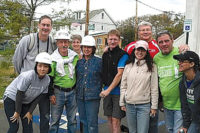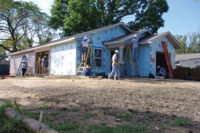Jimmy Carter Work Project 2003
One of the key words heard consistently over the 27-year history of Habitat for Humanity International has been "partnership." According to the model, local Habitat affiliates partner with churches, the business community and families in need of simple, decent housing. This partnership is just that; it is not a charity. Habitat builds homes for - and with - good people in need of a decent place to live. Homeowners help build their own home and others. They make a down payment in dollars, sign a mortgage and make monthly payments. The homes are sold at no profit, and the mortgages are interest-free. Since the founding of Habitat by Linda and Millard Fuller in 1976, these unique partnerships have empowered over 130,000 families worldwide to become homeowners.
The Habitat model took a major leap forward in 1984 when former President Jimmy Carter and wife Rosalynn joined other Habitat volunteers working at a site in New York City. This event was the first of the internationally recognized annual Jimmy Carter Work Projects (JCWP). These high-profile projects involve the "blitz building" of numerous Habitat homes in the course of one week of construction. Of course, months, even years of preparations are made prior to thousands of volunteers descending on the work site.
For a good many years, the roofing industry has had partnerships with Habitat on many levels. Notably, many roofing contractors and distributors partner with their local Habitat affiliates for the roofing of one or more homes each year. These in-kind contributions help keep the costs low, but also help the local Habitat affiliates build more homes.
One of the best examples of partnership occurred in 1989 when the JCWP was held in Milwaukee. The weather was abysmal, and constant rain in the early part of the build threatened to ruin the entire event. The biggest problem was that the roofs were too steep - and at times too damp - for unskilled volunteers to safely negotiate. President Carter went on the radio and called on the professional roofing community to step in and help out. The next day the work site was virtually overrun with professional roofers who joined in and took care of the roofing.
In addition to this, several roofing manufacturers have quietly contributed shingles for the construction of thousands of homes in the United States and overseas. All the homes built by the JCWP 2003 were roofed with shingles contributed by roofing manufacturers Elk Corp. and CertainTeed Corp.
Scope of the Project
The site of the JCWP moves all over the world from year to year. The JCWP 2003 was held this summer in three U.S. cities, all in the South: LaGrange, Ga.; Anniston, Ala.; and Valdosta, Ga. In total, the JCWP 2003 built 92 homes: 35 in Anniston, 32 in LaGrange and 25 in Valdosta. Roofing Contractor participated in the construction of House 41, the residence of Ms. Erica Berrian and her daughter KuChara, in Valdosta.
The homes were all of wood frame construction with vinyl siding, fiberglass shingle roofing and vinyl windows. All 25 homes in Valdosta were covered with Elk Prestique shingles and the homes in LaGrange and Anniston each received a CertainTeed roof.
On arrival at the various sites, the 4,000 (mostly first-time) volunteers were all greeted with a sea of foundations with building components stored nearby in staging areas, on the lot, or in containers set about the site. In Valdosta, each site had a container with the materials staged neatly in the reverse of their use as the construction progressed. This kind of organization is needed to complete the construction in one week, even of simple structures such as these. Most of the workers have some experience, but many have none. While the key leaders of construction are professionals, many of the site leaders are volunteers with a variety of skills, but not necessarily construction pros.
Welcome South, Brother
The South in the summertime can be a bit unwelcoming at times. The JCWP 2003 sites were each treated to the typical, although somewhat uncivilized, combination of summer heat and rain for the first few days of construction. Yes, the first few days, the ones before the structures were dried-in. This combination forced a somewhat long, wet, muddy, sloppy, sweaty first day for most volunteers. The only (mostly) dry person working on House 41 was the quartermaster of the material container.At least the rain kept the bugs and gnats down - for the first few days, that is.
Work proceeded in spite of the rain and most houses were dried-in according to or ahead of schedule. Just as the workers began to head up to shingle the roofs, the sun came out in time to bake the would-be roofers. But the roofs went on according to schedule and they looked terrific. The Elk shingles used in Valdosta were all "Weathered Wood" and were cast perfectly with a wide variety of siding and trim colors.
During the course of the week most of the activities involved construction, but there was some other action as well. Nationally syndicated radio host Clark Howard, sponsored House 38 in Valdosta and held his daily broadcast on the site for several days during the week of JCWP 2003. Howard sponsors the construction of several homes every year with the Atlanta affiliate of Habitat. Howard conducted several interviews on the site including former President of Zambia, Kenneth Kaunda. He also introduced one interviewee as "...a 79 year-old volunteer... what is your name, sir?" "Jimmy Carter" came the answer.
Clark Howard works from WSB, the oldest radio station in the South. It is said that WSB originally was an acronym for "Welcome South, Brother." I assume the reference had to do with something other than the heat, rain and bugs. I prefer to think it has more to do with the more important and truly welcoming features of the South, such as Krispy Kremes.
All Business
Carter works the crowds as part of the JCWP, but when it comes to construction, he is all business. Each year he works with the local JCWP affiliates in the preparation for construction and approves all plans. When it comes time to build, he instructs the volunteers not to ask him for photo opportunities. He and his wife Rosalynn are here to work. He has become known for taking the time to go to each home and pose with the workers and the homeowners. He invariably says after the brief photo-op is concluded, "Now get back to work!"
Carter enjoys the distinction of being a Nobel Laureate, former President of the United States, and now a popular and respected elder statesman. But he is quoted as saying, "I get a lot more recognition for building houses in partnership with people than I ever got for the Camp David Accord or Salt II or for all our projects in Africa or Asia or anything I do now since I left the White House. I can walk down the aisles of airplanes talking with people and invariably the number one thing that everybody says is, ‘Tell me about Habitat.'"
Day by Day
The work of Habitat for Humanity International goes on all year. The JCWP is simply one piece of the work that begins at the headquarters in Americus, Ga., and is conducted by local affiliates in over 80 countries worldwide every day. HFHI managed to build 100,000 homes in its first 25 years (1976-2001), and has set a goal to build another 100,000 in its next 5 years.Many other companies in the roofing industry have been involved in Habitat over the years including The Dow Chemical Company and GAF Materials Corp. Think you may want to point some of your firm's community service efforts to this important work? The best way to get on board is to contact your local Habitat for Humanity affiliate. A listing of local affiliates may be found online at www.habitat.org, or by calling the HFHI headquarters at 229.924.6935.
And if you are adventurous, mis amigos, the Jimmy Carter Work Project 2004 is set to be held in Puebla and Veracruz, Mexico!
Side Bar: Habitat for Humanity International
- HFHI is a non-profit, ecumenical Christian housing ministry.
- HFHI seeks to eliminate housing and homelessness from the world, and to make decent shelter a matter of conscience and action.
- HFHI has built more than 100,000 houses around the world providing more than a half-million people with safe, decent, affordable shelter.
- HFHI was founded in 1976 by Millard Fuller along with his wife, Linda
- Through volunteer labor and donations of money and materials, HFHI builds and rehabilitates simple, decent houses with the help of homeowner (partner) families.
- HFHI houses are sold to partner families at no profit, financed with affordable, no-interest loans.
- The homeowner's monthly mortgage payments are used to build still more HFHI homes.
- Throughout the world, the cost of houses varies from as little as $800 in some developing countries, to an average of $46,600 in the United States.
- HFHI's work is accomplished at the community level by affiliates - independent, locally run, nonprofit organizations.
- There are more than 1,900 active affiliates in 79 countries including all 50 states, the District of Colombia, Guam and Puerto Rico.
- Partner families are selected based on level of need, willingness to participate in the program and ability to repay the no-interest loan.
- Neither race nor religion is a factor in choosing partner families.
- HFHI is not a governmental agency and does not accept government funds for construction of houses, but does work with government agencies toward fulfilling its mission of eliminating poverty housing.
- HFHI is managed by an ecumenical, international board of directors.
Links
Looking for a reprint of this article?
From high-res PDFs to custom plaques, order your copy today!





